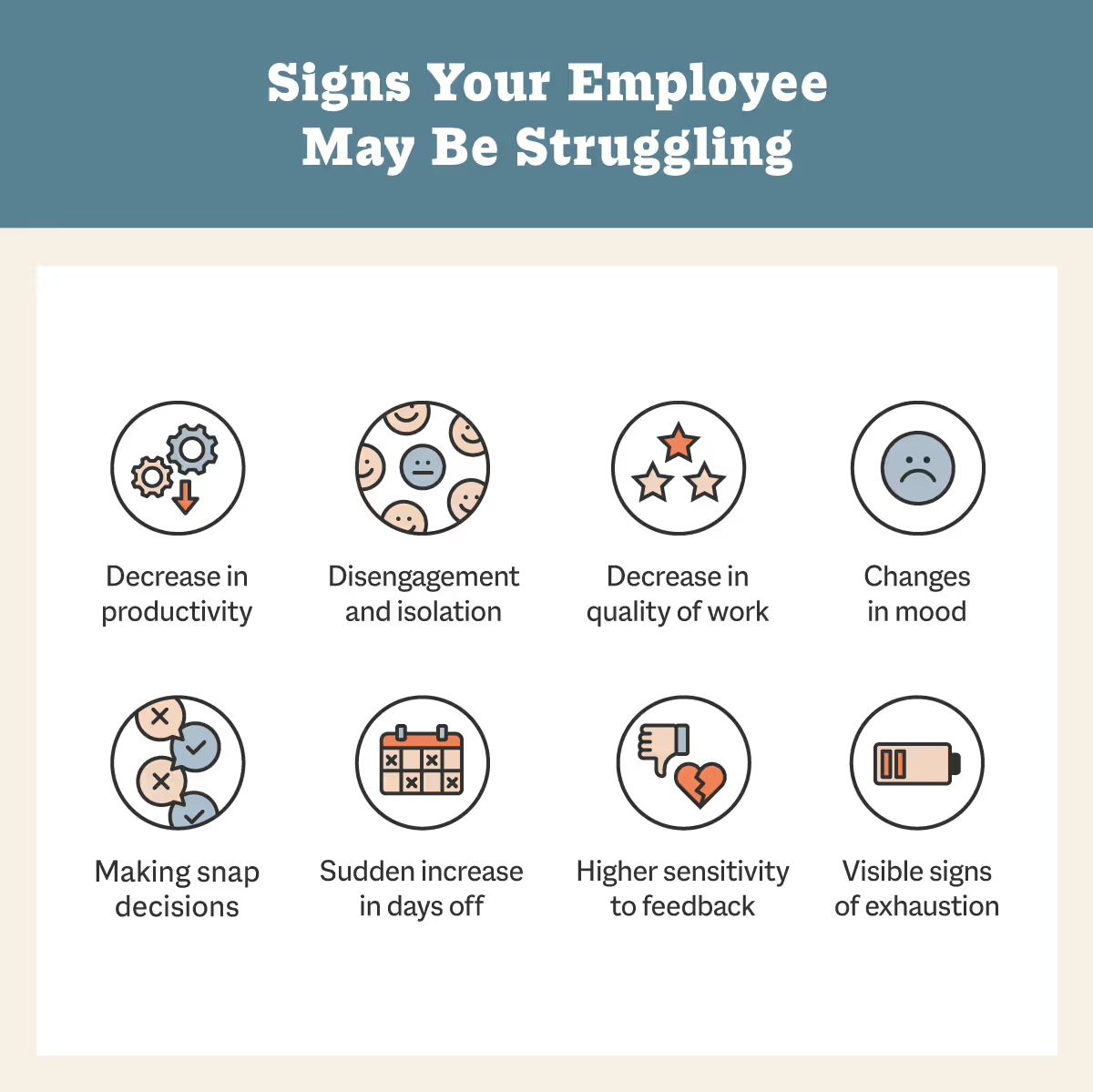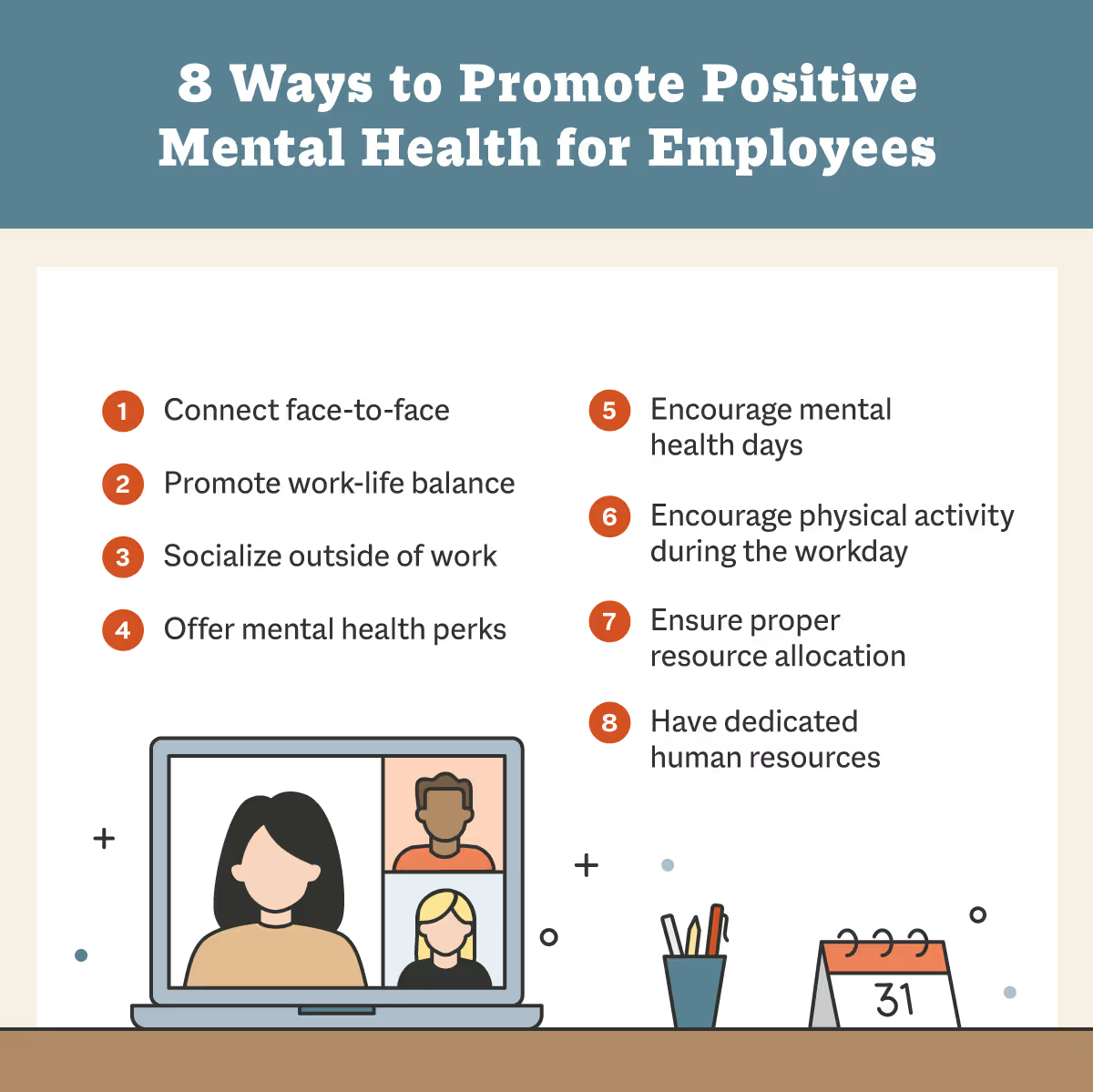Mental Health in the Workplace: A Guide for Prioritizing Employee Mental Health
Mental Health in the Workplace: A Guide for Prioritizing Employee Mental Health

Mental health has been a rising concern over the last few years, particularly in correlation with the rise of the virtual workplace. Roughly half of the American workforce reported feeling more burnout after the introduction of remote work during the COVID-19 pandemic. While the pandemic is not the sole cause of the Great Resignation, many major reasons over 47 million Americans left their jobs in 2021 relate to mental wellness, such as working too many hours.
Employers must prioritize mental health in the workplace by recognizing the signs of mental health struggles and creating initiatives to form positive environments and support team members. Companies like Smith.ai are there to help with business process outsourcing services you can lean into when your staff is overwhelmed.
Continue reading or skip to the infographic below to learn more about the warning signs of struggling mental health in employees and ways you can support your employees.
Each autumn brings awareness to the different mental health battles people face every day. National Suicide Prevention Month runs throughout September. October holds Mental Illness Awareness Week, World Mental Health Day, and more. November features both International Stress Awareness Day and Bullying Awareness Month.
If you’re struggling with your mental health or are experiencing thoughts of suicide, seek help. For immediate medical emergencies, call 911. Call or text 988 for the National Suicide & Crisis Lifeline.
Mental health in the remote workplace
Though it’s been proven that productivity has increased with the rise of the virtual workplace, mental health during COVID-19 and thereafter has seen different trends.
Initially, after the immediate hit of the coronavirus pandemic, over 50% of Americans felt more stressed as a result of the shift to remote work. However, many people also felt relief working remotely with more flexibility. The difference comes down to the person and the company they work for.
While the exact numbers may have changed as some companies have brought team members back on-site, the current state of mental health in the virtual workplace speaks a different story now in 2022 going into 2023.
After nearly three years of remote work, the reasoning behind the increased stress levels comes from a higher workload and longer hours. For some, the almost three years of feeling isolated and lacking in-person interactions had led to employees not feeling connected or like they are a part of a team.
The current state of mental health in the workplace — remote or not — needs improvement, and that’s something business owners and leaders can work on correcting.

Why is mental health important in the workplace?
The conversation about remote work and mental health is important for business owners to discuss for several reasons — it shows compassion toward their team and the company's future.
In the U.S., unresolved depression in employees leads to a 35% decrease in productivity, which contributes to an average of 31.4 days per year out of work and another 27.9 lost to unproductivity. However, the seriousness of mental health in the workplace goes beyond reasons like company success. This topic pertains to the safety of one's life, which is not something to take lightly.
As a business owner, it will be difficult to hear that your employees are suffering. Try not to take this personally, as the root cause of their mental health struggles may not be work-related. However, work could be making things more difficult, so this is the time to look inward to identify areas where change is needed to create a safe space for employees.
Symptoms of poor mental health in the workplace
When an individual’s mental health is suffering, it can show in other areas of their life, including their job — though this is not always the case.
Employees who may be dealing with mental health issues may show the following signs:
- A decrease in productivity
- A decrease in quality of work
- Disengagement and isolation
- Changes in mood
- A sudden increase in days off
- Making snap decisions
- Higher sensitivity to feedback
- Visible signs of exhaustion
Overall, management and other team members may sense that the employee has lost interest in their work.
A successful business cares about their employees, and not just for their own sake. However, it’s true that a happy employee translates their satisfaction into their work. When team members’ productivity and quality of work decrease, your business is negatively impacted as well.

How to prioritize employee mental health
Companies hold a significant role in employee mental health — from preventative precautions to solution initiatives.
Americans spend most of their adult lives working. Since businesses spend so much time interacting with their employees, they are responsible for recognizing signs of mental health struggles. In a remote setting, this can be more of a challenge, so employers should be more vigilant and have initiatives in place for fostering employees' well-being.
The list below covers eight ways you can promote positive mental health in the workplace as an on-site or virtual business owner, though there are plenty of other measures you can take.

1. Connect face-to-face
For remote or hybrid businesses — or even those with staff on-site — it may be difficult to round the team up in one physical location. However, people are inherently social beings and require human connections. Thankfully, there are video conferencing apps to fill the gaps when in-person get-togethers aren’t possible.
Show your face regularly in virtual meetings and encourage your team to do the same. A company-wide policy of enforcing video on calls might do more harm than good by leading to Zoom fatigue. However, it’s important to connect face-to-face occasionally to reduce feelings of isolation.
2. Promote work-life balance
Seventy-nine percent of American workers view a healthy balance between work and personal life as a main mental health priority. Working from home makes it easy to work well beyond 5 o'clock or sign back on after dinner. However, these behaviors will lead to burnout and strain personal relationships after a while.
Encourage your team to power down and silence work communications after completing their workday. As a manager, you should consider doing the same. Employees may feel pressure to respond should emails come through after work hours or work late if they see that you’re online late. You may even consider offering an optional scheduling software solution that forces computer shutdowns or hibernations at a specific time.
3. Ensure proper resource allocation
More than half of remote workers believe their workload has increased since shifting to working from home. This can cause employees to work beyond their normal hours to finish tasks (or feel overwhelming guilt if they don't).
Re-evaluate your team's workloads and ensure you have proper resource allocation in place. If you find areas that could use reallocating, consider adjusting timelines or investing in adequate resources to fill those gaps.
Outsourcing is one way to take extra responsibilities off your internal team. Smith.ai's virtual receptionists can handle mundane tasks, like confirming appointments and processing payments, while your team focuses on profit-driving tasks. For example, if your sales team isn’t able to finish screening your influx of leads, Smith.ai’s agents will complete — or handle entirely — your outreach campaigns for you.
By taking the work your team isn’t able to fit in off their schedules, you can expect to see a boost in productivity from showing support for your team’s mental wellbeing.
4. Encourage physical activity during the workday
Seventy-six percent of the remote workforce prioritize exercise to improve their mental health. Exercise has numerous benefits, both physical and emotional. There’s nothing quite like a good workout to relieve stress.
It’s important to not only motivate your team to live active lifestyles but also to be active throughout the workday. Show your support for work-life balance by encouraging midday walks or workouts and frequent opportunities to step away from the computer.
5. Socialize outside of work
It’s been proven that social relationships benefit mental health by lightening moods and fostering connections. Workplace relationships are no exception.
In addition to face-to-face communication, it’s important to set aside time for employees to get together and not talk about work. Whether it’s a virtual happy hour or team lunch, try to schedule time at least once a month to socialize without talking about clients and assignments.
6. Encourage mental health days
Taking time off away from work can do wonders for employees' mental health. A mental health break from work refreshes the mind and allows employees to relax. Again, be sure assignments are reallocated, so employees don't return to work stressed and feeling the need to get caught up.
7. Offer mental health perks
If your business can, consider offering employees a few mental health perks. The cost of adding benefits for your staff outweighs the cost of losing valuable team members to other employers offering these perks. These can also entice candidates to apply to your business's open positions.
Some examples of mental health benefits are:
- Health insurance that covers mental health-related expenses
- Life coaching services
- Clinical mental health screenings
- Paid time off
- Flexible scheduling
- Stress management training
- Company memberships or discounts for mental health apps like Calm and BetterHelp
8. Have dedicated human resources
Some small businesses may consider cutting human resource departments to keep expenses down. However, HR is key to employee satisfaction.
HR’s responsibilities vary from hiring to enforcing workplace safety to managing benefits. HR is also there to listen and solve issues and advocate for employees. Without a dedicated HR representative, employees may feel like there is no neutral party for them to reach out to with issues such as mental health concerns.
Human resources also implement employee assistance programs (EAPs). EAPs are voluntary benefit programs that allow employees to seek help for personal or work-related problems that could interfere with their job and health. Some EAPs may include other perks mentioned above, such as coaching and health screenings.
The first step to a healthy mind
Talking about mental health in the workplace is the first step in destigmatizing and normalizing the topic. Our infographic below summarizes the tips above and some additional statistics and information on mental health in the workplace. Don't forget to share this information with your team leaders so they, too, are on the right track to promoting a safe workplace.

Remember to practice what you preach on prioritizing mental health in the workplace. If your team sees that you are not taking care of your mental health, it can set the tone for how management runs the business.
A successful business prioritizes their employees’ mental health because they know an individual produces their best work while happy and content, ultimately helping the bottom line as a business. Book a call with Smith.ai to learn more about how we can use our outsourcing services to elevate pressures off your internal team.
Sources: Mental Health America | WHO | NAMI | HBR | HBR |
Take the faster path to growth. Get Smith.ai today.
Key Areas to Explore
Technical Implementation Terms
Voice user interface (VUl) design
Speech recognition integration
Text-to-speech optimization
API connectivity and webhooks
Real-time data synchronization

Your submission has been received!














.svg)



